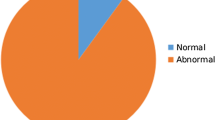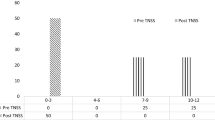Abstract
Objectives: The aim was to find the relationship between nasal smear eosinophil (NSE) counts and allergic rhinitis (AR) along with the impact of treatment on peak nasal inspiratory flow rates and symptom scores in these patients. Material and methods: An observational, comparative study was carried out with 75 patients of AR. Nasal smears were drawn and eosinophil counts were estimated. Nasal symptoms were assessed and compared by visual analogue scale (VAS) and peak nasal inspiratory flow (PNIF) rates before and after treatment. Equal number of healthy individuals formed the control group. Results: There was a strong association between increase in eosinophil count in nasal smears and AR (p = 0.000). A NSE count of 0.2/HPF had a specificity of 98.7%, sensitivity of 53.3%, and positive predictive value of 97.6% in the diagnosis of AR. The mean VAS scores for nasal obstruction improved from 7.35 to 1.01 and the mean peak nasal inspiratory flow from 69.00 L/min to 103.73 L/min (p < 0.0001) after treatment. The mean NSE counts reduced from 4.20/HPF to 0.090/HPF proving a strong correlation between improvement of symptom scores and NSE counts (p = 0.000) in AR. The study also determined that a PNIF value of ≤ 77.50 L/min can be used as a cut off for diagnosing nasal obstruction in these patients. Conclusion: A NSE count of ≥ 0.2 /HPF is to be considered as diagnostic of AR. Nasal congestion is the commonest symptom associated with AR and addition of systemic decongestant is required for management of these patients.



Similar content being viewed by others
References
Passali D, Cingi C, Staffa P, Passali F, BayarMuluk N, Bellussi ML (2018) The international study of the allergic rhinitis survey: outcomes from 4 geographical regions. Asia Pac Allerg 8(1):e7
Nurkic J, Ahmad MA, Arifhodzic N, Jusufovic E (2016) The role of target organ diagnosticapproach in seasonal allergic Rhinitis: nasal smear Eosinophils. Matersociomed 28(2):125–128
Skoner DP (2001) Allergic rhinitis: defnition, epidemiology, pathophysiology, detection and diagnosis. The J Allerg Clin Immunol 108(1):S2–S8
Newacheck PW, Stoddard JJ (1994) Prevalence and impact of multiple childhood chronicillnesses. J Pediatr 124:40–48
Vaidya A, PaiNagaraj STS (2015) A study on utility of nasal smearexamination in diagnosing allergic rhinitis and its histopathological correlation in allergicnasal polyps. Int J Basic Appl Med Sci 5(1):291–297
Asha’ari ZA, Yusof S, Ismail R (2010) Clinical features of allergic rhinitis and skin prick test analysis based on the ARIA classification: a preliminary study in Malaysia. Ann Acad Med Singapore 39:619–624
Sood A (2005) Diagnostic significance of nasal eosinophilia in allergic rhinitis. Indian J Otolaryngol Head Neck Surg 57(1)
Chinn S, Jarvis D, Luczynska CM, Lai E, Burney PG (1996) Measuring atopy in a multi-centreepidemiological study. Eur J Epidemiol 12:155–162
Chandrika D (2017) Allergic rhinitis in India; an overview. Int J Otorhinolaryngol Head Necksurgery 3:1–6
Saini A, Gupta M, Sharma B, Kakkar M, Chaturvedy G, Gupta M (2013) Rhinitis, sinusitis andocular disease-2085. Prevalence of allergic rhinitis in urban school children, Jaipur city India. World allergy Org J 6(1):164
Fauzi F, Sudiro M, Lestari BW (2015) Prevalence of allergic rhinitis based on World Health Organization (ARIA-WHO) questionnaire among Batch 2010 Students of the Faculty of Medicine Universitas Padjadjaran, Department of Otolaryngol AMJ December
Gani F, Lombardi C, Barrocu L, Landi M, Ridolo E, Bugiani M (2018) The control of allergic rhinitis in real life: a multicenter cross- sectionalItalian study. Clin Mol Allergy 16:4
Bousquet PJ, Combescure C, Neukirch F, Klossek JM, Méchin H, Daures JP, Bousquet J (2007) Visual analog scales assess the severity of rhinitis graded according to ARIA guidelines. Allergy 62:367–372
Hellings PW, Muraro A, Fokkens W, Mullol J, Bachert C, Canonica GW, Price D, Papadopoulos N, Scadding G et al (2015) A common language to assess allergic rhinitis control: results from a survey conducted during EAACI Congress. Clin Trans Allergy 27(5):36
Teixeira RUF, Zappelini CEM, Alves FS, da Costa EA (2011) Peak nasal inspiratory flow evaluation as an objective methodof measuring nasal airflow.Braz.j.otorhinolaryngol.(Impr.)vol.77 no.4 saopaulojuly/Aug.2011
De Souza Campos Fernandes S, Ribeiro de Andrade C, da Cunha Ibiapina C (2014) Application of peak nasal inspiratory flow reference values in the treatment of allergic Rhinitis. Rhinology. 52(2):133–6
da Cunha IC, Ribeiro de Andrade C, Augusto Cruz A (2011) Reference values for peaknasal inspiratory flow in children and adolescents in Brazil. Rhinology 49(3):304–308
Tarchalska-Kryńska B (2009) Diagnostic cytology. In: Diagnostic methods in rhinology, Krzeski A (ed), pp 83–88, Medycynapraktyczna, Cracow
Gelardi M, Marseglia GL, Licari A et al (2012) Nasal cytology in children: recent advances. Ital J Pediatr 38:51
Pal I, Sinha Babu A, Halder I, Kumar S (2017) Nasal smear Eosinophils and allergic rhinitis. Ear Nose Throat J 96(10–11):E17–E22
Bakhshaee M, Fereidouni M, Farzadnia M, Varasteh A-R (2010) The nasal smear for eosinophils, its value, and its relation to nasal mucosal eosinophilia in allergic rhinitis. Iran J Otorhinolaryngol 22(60):73–78
Ahmadiafshar A, Taghiloo D, Esmailzadeh A, Falakaflaki B (2012) Nasal Eosinophilia as amarker for allergic rhinitis: a controlled study of 50 patients. Ear Nose Throat J 91(3):122–124
Sanli A, Aydin S, Ateş G, Eken M, Celebi O (2006) Comparison of nasal smear Eosinophilia with skin prick test positivity in patients with allergic rhinitis. Kulak Burun BogazIhtis Derg 16(2):60–63
Amperayani S, Kuravi N (2011) Correlation of nasal smear Eosinophilia with class of allergic rhinitis. Indian Pediatr 48(4):329–330
Klaewsongkram J, Ruxrungtham K, Wannakrairot P et al (2003) Eosinophil count in nasalmucosa is more suitable than the number of ICAM-1-positive nasal epithelial cells to evaluate the severity of house dust mite-sensitive allergic rhinitis: a clinical correlation study. Int Arch Allergy Immunol 132(1):68–75
Acknowledgements
We would like to thank department of Otorhinolaryngology, College of Medicine and JNM Hospital, Kalyani, West Bengal University of Health Sciences for the support throughout the study.
Funding
No funding sources.
Author information
Authors and Affiliations
Corresponding author
Ethics declarations
Conflicts of interest
None.
Additional information
Publisher's Note
Springer Nature remains neutral with regard to jurisdictional claims in published maps and institutional affiliations.
Rights and permissions
About this article
Cite this article
Usha, G., Pal, I., Kumar, S. et al. Assessment of Nasal Smear Eosinophil Counts in Allergic Rhinitis: How Useful is it?. Indian J Otolaryngol Head Neck Surg 74, 540–546 (2022). https://doi.org/10.1007/s12070-022-03109-x
Received:
Accepted:
Published:
Issue Date:
DOI: https://doi.org/10.1007/s12070-022-03109-x




